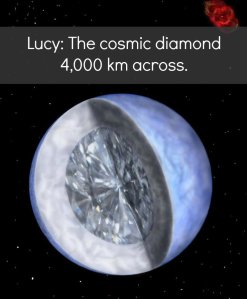

Deep in the Constellation of Centarus lies a star 50 light-years away from the Earth. This star is so…unique that astronomers nicknamed it “Lucy.” Lucy, also known as V886 Centauri and BPM 37093, is (at first glance) an ordinary white dwarf star. But it seems to hide something rather special.
As many of you may know, a white dwarf is the hot cinder left behind when a star uses up its nuclear fuel and, in essence, dies. It is made mostly of carbon and oxygen and surrounded by a thin layer of hydrogen and helium gases.
In 1992 it was discovered that Lucy pulsates as a result of its core temperature dropping below 12,000 degrees Fahrenheit (6,600 Celsius). And in 1995 scientists decided to use Lucy for an experiment. They wanted to see what she was made of. The experiment was to use the pulsation of the star to see if the crystallization theory was true.
The process that was used is called “Asteroseismology” or “Stellar Seismology,” which uses the star’s frequency spectra to determine what the composition of the star is. Essentially, it is the same way that geologists study the interior of the Earth during earthquakes.
Scientists had found that approximately 90% of Lucy’s mass had crystallized, and since Lucy’s interior core is mostly made of Carbon, it can only mean one thing….
Lucy is the biggest diamond ever found!

At 10 billion trillion trillion carats, not only is this diamond forever, it squashes the last diamond to hold the record, the Golden Jubilee, at 546 carats.
It is theorized that our Sun will one day go through the same phase. After it loses its outer shell and becomes a white dwarf, it too will crystallize and live out it’s end of days in spectacular form, enjoying it’s own Diamond Jubilee.
FQTQ is managed by two people, Jaime and Jolene. We want to make science fun and engaging. We’re doing that. With your help, we can do even more.
Below you can support us, get to know us, and access extra content: